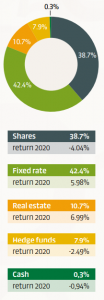HEINEKEN and you pay a premium for the accrual of your pension. But in addition, an important part of your pension is earned with the income from investments. Without investments, our pension would be much more expensive or much lower. But investments are not without risk either. Anyone who is going to invest should receive a warning : “you can lose (a part of) your investment”. The pension fund also runs investment risks. What about the investments risk? And how are these risks managed?
Investment risks
According to the theory, a higher risk is rewarded with a higher return in the long run. But a pension fund is obviously not allowed to take irresponsible risks. That would be gambling with other people’s money.
The HPF manages risks by spreading its assets over different types of investments. You can expect a higher return from shares, certainly in the long term than from a normal savings account, but the risks are also greater along the way. For the sake of balance, the HPF therefore also invests part of its assets in relatively safe investments such as government bonds. The return on these are lower, but owning government bonds makes us less sensitive to changes in interest rates. In addition, the pension fund invests, for example, in hedge funds that provide protection against depreciation of shares. Incidentally, that did not work last year, as we had expected, but it did during previous crisis’s. Our investments in real estate, for example, also serve to spread the investment risk. And when stocks do poorly in one country or sector, they can do well in another country or sector. So we take risks, but don’t put all your money on one card.
The return on total assets of HPF was 1.6% last year. In 2019 it was 13.4% and in the first half of this year it was 4.7%.
In the diagram below you can consult the distribution of the investments and also see what the return was in 2020.



